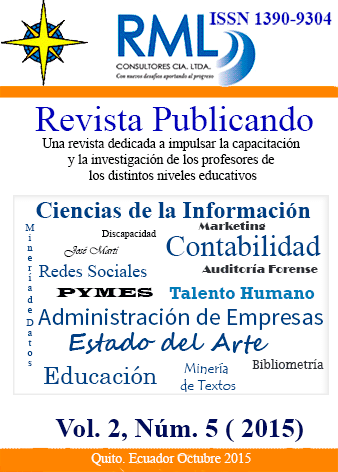Abstract
The aim of this article is to analyze the situation of poverty that have been supporting people living in rural areas of Ecuador. The study considers the policies that governments have taken since 2000-2010 to fight poverty in general and specifically rural. The revision of history, can learn from when it comes dragging this social phenomenon in the country. Furthermore, the social investments they have made past administrations to the current President Rafael Correa are analyzed and coverage levels are compared between countries of Latin America, the PTC Conditional Transfer Programs, which are state investments in human capital prevent intergenerational reproduction of poverty. Finally the correlation between social investment and rural poverty is determined to confirm that when larger amounts of money are allocated to the care of the most vulnerable through transfers, the percentage of urban and rural poverty decreases significantly. The conclusions that can be reached are that one of the causes of rural poverty is due to the inertia of developments since the colonial times, when the Indians were practically slaves or if you will, servants of feudalism adopted America, brought from medieval Europe
References
Ayala, E. (2008), Resumen de Historia del Ecuador. Quito. Corporación Editora Nacional. Tercera edición.
Báez, R; Cueva, A; Mejía L; Moncada, J; Moreano, A; Velasco, F. (1995) Ecuador: Pasado y Presente. Quito. Libresa.
BCE, (Banco Central del Ecuador).2015.Disponible en:http://www.bce.gob.ec
Cecchini, S; Madariaga, A (2011). Programa de transferencias condicionadas: Balance de la experiencia reciente en América Latina y El Caribe. Santiago de Chile. Naciones Unidas, CEPAL, ASDI.
CEPAL, (Comisión Económica para América Latina). Base de datos estadísticos de comercio exterior 2012. Disponible en: http://websie.eclac.cl/badecel/badecel_new/basededatos.asp
Chiriboga, M; Wallis, B. (2010). Diagnóstico de la pobreza en Ecuador y respuestas de Política Pública. Santiago de Chile. Rimisp-Centro Latinoamericano para el Desarrollo Rural.
Del Valle, A. (2010) European Review of Latin American and Caribbean Studies 88, April. p 61-76
Dirven, M. (2007). Pobreza rural y políticas de desarrollo: avances hacia los objetivos de desarrollo del Milenio y retrocesos de la agricultura de pequeña escala. Chile. CEPAL.
INEC, (Instituto Nacional de Estadísticas y Censos) 2001
http://www.inec.gob.ec/cpv/descargables/fasciculo_nacional_final.pdf
INEC. (2015). Archivo Nacional de Datos y Metadatos Estadísticos (ANDA). Retrieved 6 de Abril, 2015, from http://anda.inec.gob.ec/anda/index.php/catalog/SOCDEMO
Feres, J; Mancero, X. (2001) Estudios estadísticos y prospectivos Enfoques para la medición de la pobreza. Breve revisión de la literatura. Chile. CEPAL.
Kanbur, R; Squiere, L. (1999). La evolución del pensamiento sobre la pobreza: Explorando las interacciones. Artículo del Banco Mundial.
Martínez, L. (2002) Desarrollo rural y pueblos indígenas: Aproximación al caso ecuatoriano. Quito. Ecuador Debate Nro. 55 CAAP. pp. 14
Meller, P. (1999) Pobreza y Distribución del Ingreso en Chile: Década del 90. CIEPLAN Chile.
MFE, (Ministerio de Finanzas del Ecuador) 2015. Disponible en: http://www.mfe.gob.ec
PNUD (Programa de las Naciones Unidas para el Desarrollo) 2010. Informe sobre Desarrollo Humano 2010 Edición del Vigésimo Aniversario. La verdadera riqueza de las naciones: Caminos al desarrollo humano.
http://hdr.undp.org/sites/default/files/hdr_2010_es_complete_reprint.pdf
Raczynski, D. (2002). Equidad, Inversión Social y Pobreza. Innovar en cómo se concibe, diseña y gestiona las políticas y los programas sociales. MIDEPLAN – CEPAL, mes de mayo p 23- 24.
Schejtman, A.,.Berdegué, J (2007). Programa Dinámicas Territoriales Rurales. Documento de trabajo N º1. Santiago de Chile. Rimisp Centro Latinoamericano para el Desarrollo Rural.
Villatoro, P. (2005), Programas de Transferencias Monetarias Condicionadas: Experiencias en América Latina. Revista de la Cepal. Nro. 86, agosto. p.89.

This work is licensed under a Creative Commons Attribution-NonCommercial-ShareAlike 4.0 International License.
Copyright (c) 2019 Mario Alejandro Pérez Arévalo, León Benigno Arguello Núñez, Walther Boanerges Purcachi Aguirre
